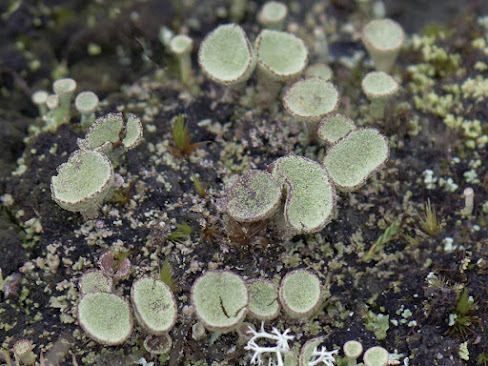We met at the Burbush car park and crossed the road to take the squelchy grass strip along the edge of a line of aging birches, where several Birch Polypore Piptoporus betulinus of various sizes were seen.
Wavy Bitter-cress © Sue Skarstein
Turning through a narrow strip of woodland and then skirting the wooded edge of a paddock, keen eyes spotted foraging Chaffinches a Dunnock, Great Tits, Redwings and Long-tailed Tits. At least a couple of Nuthatches voiced their displeasure at presumably our presence.
Orange Peel Fungus © Bill Johnson
Having been scolded, we went out into the heather to a gradual climb to pass through another small area of wood and up to Castle Hill Lane, the lane serving some country houses. The lane passed through Coffins Holms, a long wooded area, well over 200 years old, and featured several still standing dead and eye catching oaks, some having lost their bark, and gnarled birches. A fallen trunk was covered with what looked like broken cauliflower, the remains of something unidentifiable. Someone coveted the roots to be used in a garden stumpery.
 |
| Lichen thought to be Cladonia grayi © Richard Smith |
Nearby, a white tip was spotted protruding through the fallen leaves, a Common Inkcap Coprinopsis atramentaria was hazarded. Above the lane were Blue Tits and enough Goldfinches to warrant the accolade of being called a charm. Down the slope but upwind of us were some Fallow Deer.
It was pointed that the flowers and developing single berries on the Butcher's Broom bushes we were seeing during the walk were in fact sprouting from flattened stems that have evolved to look like leaves.
Butcher's Broom © Chris Robinso
Leaving the lane at the end of the wood and walking down alongside a paddock two Mistle Thrushes were seen before we started down the slope, where a narrow path through heather took us to the return track. We bypassed a muddy section in the belt of trees of Burnt Axon. As a result of the detour, we came across some diminutive Yellow Stagshorn Calocer viscosia. JE






